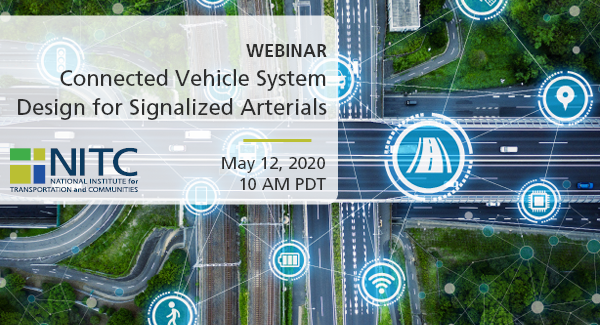
PRESENTATION ARCHIVE
OVERVIEW
It can be expected that connected vehicles (CVs) systems will soon go beyond testbed and appear in real-world applications. To accommodate a large number of connected vehicles on the roads, traffic signal control systems on signalized arterials would require supports of various components such as roadside infrastructure, vehicle on-board devices, an effective communication network, and optimal control algorithms. In this project, we aim to establish a real-time and adaptive system for supporting the operations of CV-based traffic signal control functions. The proposed system will prioritize the communication needs of different types of CVs and best utilize the capacity of the communication channels. The CV data sensing and acquisition protocol, built on a newly developed concept of Age of Information (AoI), will support the feedback control loop to adjust signal timing plans.
Our multidisciplinary research team, including researchers from transportation engineering and electrical engineering, will carry out the project tasks along four directions that capitalized on the PIs’ expertise:
- Data collection and communication, in which the proposed system will be based on the AoI, prioritize the data needs of different types of CVs, and optimize the communication network;
- Dynamic traffic signal coordination, which will concurrently facilitate the progression of traffic flows along multiple critical paths;
- Smart traffic signal control, where both operational efficiency and safety improvement are accounted for at signalized intersections; and
- Multimodal system design, which will integrate transit signal priority (TSP) and suppression controls for accommodating connected buses.
This project addresses the urgent needs in CV system designs and offers control foundations to support the operations of urban signalized arterial in a CV environment.
KEY LEARNING OUTCOMES
- Identify the data collection and communication challenges in connected vehicle-based systems.
- Design dynamic signal coordination plan under the connected vehicle environment.
- Develop smart and multi-modal traffic signal control system.
THE RESEARCH
This webinar is based on a study funded by the National Institute for Transportation and Communities (NITC) and conducted at the University of Utah. Read more about the NITC research: Connected Vehicle System Design for Signalized Arterials.
SPEAKERS
Xianfeng Terry Yang, University of Utah
 Dr. Yang is an Assistant Professor in Transportation Engineering at the University of Utah. He received his Ph.D. and M.S. degrees in Civil Engineering from University of Maryland, College Park and received his B.S. degree in Civil Engineering from Tsinghua University (Beijing, China). His current research areas includes evacuation planning and operation, traffic operations with connected automated vehicles, intelligent transportation system, traffic safety, network flow modeling, and unconventional intersection design. His research is sponsored by NSF, USDOT, FHWA, UDOT, and MSHA. He is the member of TRB Traffic Signal System and Emergency Evacuations committees. He is also an Associate Editor of ASCE Journal of Urban Planning and Development and panelist of NSF and NCHRP.
Dr. Yang is an Assistant Professor in Transportation Engineering at the University of Utah. He received his Ph.D. and M.S. degrees in Civil Engineering from University of Maryland, College Park and received his B.S. degree in Civil Engineering from Tsinghua University (Beijing, China). His current research areas includes evacuation planning and operation, traffic operations with connected automated vehicles, intelligent transportation system, traffic safety, network flow modeling, and unconventional intersection design. His research is sponsored by NSF, USDOT, FHWA, UDOT, and MSHA. He is the member of TRB Traffic Signal System and Emergency Evacuations committees. He is also an Associate Editor of ASCE Journal of Urban Planning and Development and panelist of NSF and NCHRP.
PROFESSIONAL DEVELOPMENT
This 60-minute webinar is eligible for 1 hour of professional development credit for AICP (see our provider summary). We provide an electronic attendance certificate for other types of certification maintenance.
LEARN MORE
Sign up for our newsletter to get updates on our events.
Image by metamorworks/iStock
This webinar is hosted by the Transportation Research and Education Center (TREC) at Portland State University. The research was funded by the National Institute for Transportation and Communities (NITC), a program of TREC and one of five U.S. Department of Transportation national university transportation centers. The NITC program is a Portland State-led partnership with the University of Oregon, Oregon Institute of Technology, University of Utah and new partners University of Arizona and University of Texas at Arlington. We pursue our theme — improving mobility of people and goods to build strong communities — through research, education and technology transfer.
